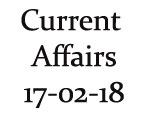-
Current Affairs 17th February 2018
Updated : 17-Feb-2018
Current Affairs 17th February 2018 - Important Points
- Scientists of which university discovered new class of antibiotics in soil - Rockefeller University
- Name of Indian engineer awarded with Sci-Tech Oscar Award - Vikas Sathaye
- Who sworn in as new Prime Minister of Nepal - KP Sharma Oli
- Who sworn in as new President of South Africa - Cyril Ramaphosa
- ONGC to introduce Asia’s first large scale CO2 injection technique at - Gandhar field
Current Affairs 17th February 2018 - Details
Scientists of which university discovered new class of antibiotics in soil - Rockefeller University
The Rockefeller University researchers have findout a new class of antibiotics in soil that is able to kill various antibiotic-resistant microorganisms. The research was issued in the “Nature Microbiology” journal on February 12th, 2018.
Method of study
The new family of antibiotics comes from particles present in a large variation of soils.
The team studied over 1000 soil samples to better know how these peptides are formed and how to exploit them for combat bacteria. After gathering soil samples, analysts chose daptomycin antibiotic to work as a form of guide.
The analyst team then utilised DNA information that encodes for manufacturing of the antibiotic in daptomycin. After observing the samples, they came to know about a new family of antibiotics 'Malacidins'.
The findings
The new antibiotic, known as Malacidins, was capable in sterilizing methicillin-resistant Staphylococcus aureus. The bacteria attacked with the malacidins did not formed any resistance.
However, Malacidin type is not a universal cure against all bacteria. This is only effective against gram-positive bacteria with a very thick cell-wall.
Therefore, this antibiotic cure would not be capable against gram-negative bacteria including pneumonia and Urinary Track Infections.Name of Indian engineer awarded with Sci-Tech Oscar Award - Vikas Sathaye
An Indian engineer, Vikas Sathaye, was currently respected at the Oscars Scientific and Technical Awards 2018 at Beverly Hills in Los Angeles, with the Scientific and Engineering Academy Award. Sathaye got the award along with his team for their efforts towards the concept, layout, engineering and the operation of the Shotover K1 Camera System during his assignment at Shotover Camera Systems in Queenstown, New Zealand.
About Shotover K1 Camera System
The Shotover K1 Camera System is a camera mount that is used for aerial photography. The 6-axis stabilised aerial camera mount can be connected to the base of a helicopter, which takes the camera and lens.
The main function of the camera mount is assuring a steady footage by removing any shakings from reaching the camera. The innovative creation, facilitates vast creative freedom and issues a clear, unwavering photographs and videos.
About the Makers
The Innovation-planners team consist of Vikas Sathaye, Brad Hurndell, John Coyle and Shane Buckham. The Shotover Camera Systems Ltd was initiated by entrepreneur Coyle, and Sathaye worked in a compressed team. Coyle conceptualise a device in which cameras could be mounted and utilised to shoot challenging aerial photographs.
Sci-Tech Oscar Awards
The Academy’s Scientific and Technical Awards esteems Single and organisations who have contributed extremely to motion-pictures with their discoveries and innovations. The awards were 1st given at the 4th Academy Awards ceremony in November 1931.
The Scientific and technical achievement awards are deliberated on 3 levels:
- Technical Achievement Award as a certificate.
- Scientific and Engineering Award as a bronze tablet.
- Academy Award of Merit as an Oscar statuette.
Who sworn in as new Prime Minister of Nepal - KP Sharma Oli
KP Sharma Oli took oath as Nepal’s PM for the 2nd time. He is the 41st PM of Nepal. He was given the oath of office and secrecy by President Bidya Devi Bhandari. He is well-known for his pro-China stance and had worked as the Nepal’s PM from October 2015- August 2016.
Background
In the freshly completed Parliamentary elections, Left alliance of CPN-UML headed by Oli and CPN-Maoist Centre headed by Prachanda had won about 2/3 majority in Parliament. Oli’s party CPN-UML won 121 seats in total 275 members Parliament, declaring it largest party in Parliament. The Nepali Congress had secured 63 seats while CPN-Maoist Centre won 53 seats.
The total power of CPN-UML and CPN-Maoist Centre was 174, adequate to arrange a majority government at the Centre. KP Sharma Oli’s Prime Minister nomination was aided by UCPN-Maoists, Madhesi Rights Forum-Democratic and Rastriya Prajatantra Party Nepal along with thirteen other small parties.
Comment
The elections success was seen as concluding step in Nepal’s transition to a federal democracy after a decade-long civil war till 2006 that declared over 16,000 lives. In 2015 Nepal had accepted new Constitution that divides Nepal into 7 federal states.
Who sworn in as new President of South Africa - Cyril Ramaphosa
Leader of ruling African National Congress, Cyril Ramaphosa, has took oath as new President of South Africa. He was nominated as new president by the ruling party politicians commanding 400 members parliament following the resignation of scam-infected Jacob Zuma. He will have balance 1-year term of his predecessor. Before this, he was deputy President since 2014.
Cyril Ramaphosa
He was born in Soweto, Johannesburg, in 1952. He was arrested in 1974 and 1976 for anti-apartheid activities. He had initiated largest workers union, the National Union of Mineworkers, in South Africa in 1982. He was Chairman of the National Reception Committee which arranged for the release of Nelson Mandela from prison in year 1990.
In year 1994, he became Member of Parliament and chairperson of constitutional assembly. He had shifted into full time business in 1997, grooming as one of the South Africa’s richest businessmen.
ONGC to introduce Asia’s first large scale CO2 injection technique at - Gandhar field
State operated Oil and Natural Gas Corporation is designing to introduce CO2 injection technique in its Gandhar oil field in Gujarat. It will be 1st large-scale CO2 injected programme in Asia.
Its aim is to recover additional 20 million barrels of crude oil under enhanced oil recovery programme. EOR programme focuses at mending about 20 percent of residual oil from ageing oil fields to enhance India’s energy security.
Key Points
Gandhar situated in Gujarat is one of ONGC’s biggest brownfields and was located in 1983. The field generates about 30,000 barrels of oil daily and is on the decrease.
In this project, ONGC proposes to invest $75 million in CO2 acquisition and additional $200 million in injector producer network to regain an additional 15 percent of residual oil tresently costed at $1.36 billion. It will be working in 20 months. ONGC is in allocutions with National Thermal Power Corporation for using about five-million tonnes of released CO2 gas from the latter’s Gandhar station.
CO2 injection technology
CO2 injection technology is a confirm concept in the West including the United States and Canada. Using this, CO2 gas is released with residual oil in the ageing field in which final oil generation has been decreasing. It decreases its thickness and makes it easier to move oil from the rock holes. CO2 gas also expands oil, thereby forcing it towards the generating tank for purification.














